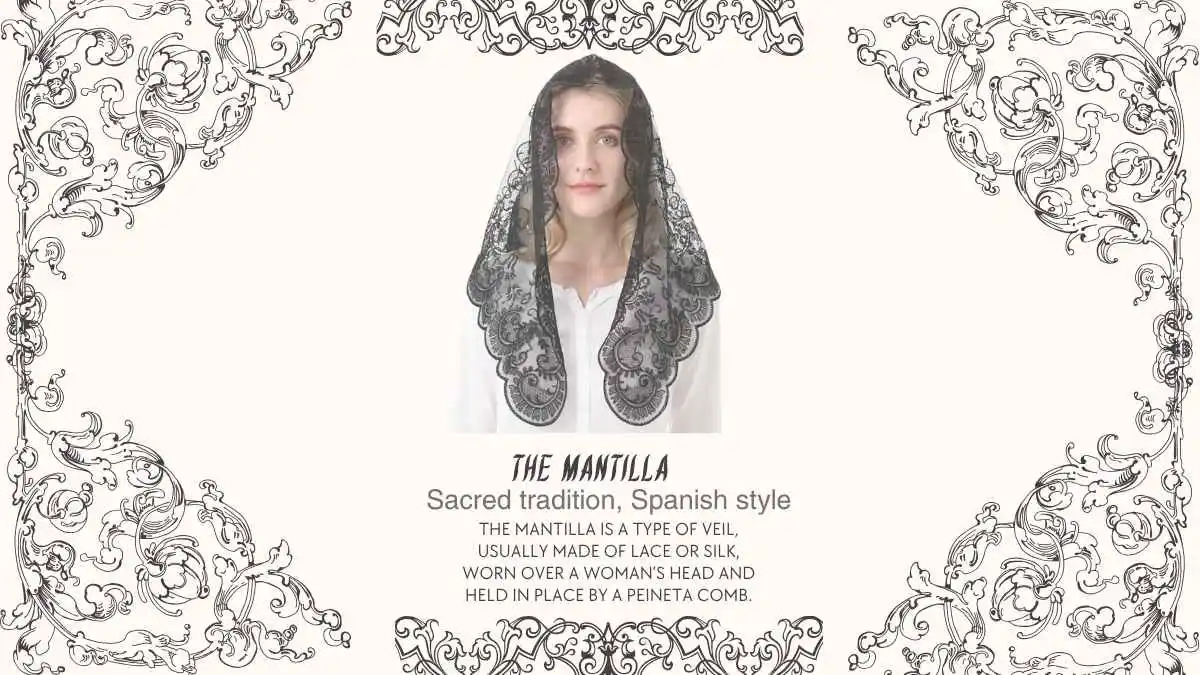FASHION
The Mantilla: Sacred Tradition and Spanish Style

Few traditional garments evoke the rich blend of religious reverence and cultural elegance like the mantilla. This delicate lace or silk veil, often worn draped over a high comb known as a peineta, carries centuries of history rooted deeply in Spanish heritage and Christian devotion. Whether gracing solemn Holy Week processions, royal weddings, or papal audiences, the mantilla remains a powerful symbol of modesty, grace, and identity.
What Is a Mantilla?
The mantilla is a type of veil, usually made of lace or silk, worn over a woman’s head and held in place by a peineta comb. By using this accessory, the veil is lifted at a slight angle and improves the silhouette around the face. Though most people expect mantillas to be part of Spanish culture, Latin Americans continue to wear them for events held in church.
It stands out among other head coverings thanks to its lace-covered or sheer fabric — it is mainly prepared for special occasions. Even though the this Spanish garment is mainly connected to religion, it is now also worn at bullfights, weddings, and common festivals in Spain.
Historical Origins and Royal Influence
Worn by Spanish women in the 16th century, this lace veil was a shirt-veil that helped them keep their outfits modest. Beginning in the 17th and 18th centuries, Spanish nobility began wearing the garment as a big trend. Giving it a place in formal wear and helping it gain importance in Spanish society were things she did as Queen of Spain in the 19th century. Yet after Queen Isabella stepped down, mantillas were primarily worn only to religious and official occasions.
Religious Symbolism and Scriptural Foundations
For a long time, Christian traditions have promoted women covering their heads while worshiping, motivated mostly by 1 Corinthians 11:5-6, which talks about head coverings as a mark of respect and authority. You can see humility and respect for God in the way women use a mantilla.
Catholic ladies in Spain and Latin America are often seen in mantillas at Mass, Holy Week, and special Marian celebrations. Maintaining this tradition, Eastern Orthodox, Mennonite, and Plymouth Brethren women demonstrate that it is shared by many Christian denominations, not just by Catholics.
Types and Colors: Meaning and Usage
- Black mantillas: Typically worn during mourning, papal audiences, and somber religious events.
- White mantillas: Reserved for weddings, virgins, and certain dignitaries granted the privilège du blanc (permission to wear white in the pope’s presence).
- Other colors occasionally appear in cultural festivals but lack strict religious symbolism.
When and Where to Wear It
Mantillas are traditionally worn during specific occasions, emphasizing respect and formality. These include:
- Religious ceremonies such as Mass, Holy Week processions, and Marian feast days.
- Formal social events like weddings and baptisms.
- Cultural occasions like bullfights and regional festivals.
- Papal audiences, where black mantillas are the norm unless the wearer holds the privilège du blanc.
Wearing the cultural headpiece outside these contexts may seem out of place or overly formal, as it is tied closely to tradition and ritual.
The Peineta: The Mantilla’s Iconic Partner
In order to keep the veil and add height, Spanish women would mount a large tortoiseshell or plastic peineta comb called the peineta under their mantilla. A veil’s clip doesn’t just secure the veil, but also makes Spanish traditions more prominent each time someone wears it. From place to place, you can find rooms with decorative art that reflects the area’s culture and traditions.
How to Wear it Correctly
Draping a mantilla is both an art and a tradition. To wear one properly:
- Start by placing the peineta high on the back of the head.
- Arrange it over the peineta, allowing it to cascade over the shoulders.
- Secure with hairpins as needed to keep the veil in place.
- For weddings, the white mantilla should complement the bridal gown and hairstyle.
- For religious events, the veil should be modest and elegant, covering the head respectfully without obstructing the face.
Proper wearing conveys respect for the garment’s symbolism and cultural roots.
Mantilla vs. Other Religious Veils and Head Coverings
While it is a specific Spanish tradition, many cultures have analogous veils:
- Chapel veils: Similar in purpose but usually simpler and less decorative.
- Hijabs: Worn by Muslim women for modesty, but stylistically and culturally distinct.
- Mantós: Larger shawls used in Latin America, differing in size and usage.
Understanding these distinctions highlights the mantilla’s unique position in Christian and Spanish heritage.
The Privilège du Blanc: Wearing White Before the Pope
The occasional honor known as privilège du blanc gives certain Catholic queens and princesses the privilege of wearing a white mantilla before the pope rather than the usual black. It represents both appreciation and position within the leaders of the Church.
Many times, figures such as Queen Sofía of Spain and Queen Elizabeth II (when present at Catholic events) have used this special exception. This bright and striking mantilla clearly illustrates its role in maintaining traditions, regulations, and special meanings.
Mantilla Colors, Meanings, and Occasions
| Color | Symbolism/Meaning | Typical Occasions | Who Wears It? |
| Black | Mourning, reverence | Papal audiences, funerals, and Holy Week | Catholic women, dignitaries |
| White | Purity, celebration | Weddings, privilège du blanc events | Brides, certain queens, and princesses |
| Other colors | Cultural or festive variation | Regional festivals and bullfights | Participants in traditional events |
Modern Revival and Fashion Influence
Lately, it has been used more often in religious ceremonies. Many designs for weddings and fancy wear use lace mantillas to celebrate Spain’s cultural heritage. At cultural festivals and during Holy Week, people wearing mantillas help uphold tradition and show younger generations why the practice is important.
The mantilla has gained recognition as a timeless sign of elegance thanks to being seen on TV and worn by celebrities.
Caring for Your Mantilla
Lace and silk mantillas are delicate and require careful maintenance:
- Handwash gently in cool water with mild detergent.
- Avoid wringing or machine washing to prevent damage.
- Store flat or hung on padded hangers to maintain shape.
- Keep away from direct sunlight to prevent discoloration.
- Antique mantillas may require professional textile conservation.
Proper care ensures this Spanish garment remains a cherished heirloom.
Conclusion
This traditional drape symbolizes religion, culture, and a lasting sense of beauty for those who wear it. Worn in many situations, it holds a special place in history by blending Spanish worship traditions with lovable elegance.
When we know the meaning and proper way to wear the mantilla, we can value it as a symbol as well as a piece of clothing.
For more updates, Visit Temple-publications.com
-

 BIOGRAPHY7 months ago
BIOGRAPHY7 months agoBehind the Scenes with Sandra Orlow: An Exclusive Interview
-

 HOME1 year ago
HOME1 year agoDiscovering Insights: A Deep Dive into the //vital-mag.net blog
-

 HOME1 year ago
HOME1 year agoSifangds in Action: Real-Life Applications and Success Stories
-

 BIOGRAPHY1 year ago
BIOGRAPHY1 year agoThe Woman Behind the Comedian: Meet Andrew Santino Wife




























